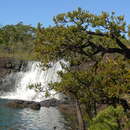Biology
provided by Arkive
Very little is known about the biology of this tree but presumably, as with the other members of the podocarp family, animals attracted to the fleshy outer covering disperse the seeds. Germination occurs in wet mud and a strong taproot is rapidly grown to anchor the young plant to the soil; so that periodic floods will not sweep it away (3). These trees are probably finely tuned to the seasonal fluctuations of water in the streams and lakes of their natural habitat. Cultivation has so far only succeeded from cuttings (3).
Conservation
provided by Arkive
Retrophyllum minus receives nominal protection within the Chûtes de la Madeline Reserve (2).
Description
provided by Arkive
This relatively small conifer is found in and around water. The convoluted trunk is dark in colour and heavily fissured, and the small leaves are green. Seeds are borne singly, hanging from the twig and surrounded by a rounded, fleshy seed coat, rather than in cones (3).
Habitat
provided by Arkive
Inhabits riverbanks and lakeshores; Retrophyllum minus is known as a 'rheophyte' because of this association (1).
Range
provided by Arkive
Retrophyllum minus is endemic to the small South Pacific island of New Caledonia (1). Today the species has an extremely restricted range being found only on the Plaine des Lacs (1).
Status
provided by Arkive
Classified as Endangered (EN - C1+2a) on the IUCN Red List 2002 (1).
Threats
provided by Arkive
This species has suffered from habitat loss on the island of New Caledonia, for mining extraction and recreational activities (1). In the dry season, bush fires threaten the small remaining population (2). Changes in the water regimes of the small rivers in the area (there is already a large dam project realised) are likely to be detrimental to the survival of this unusual tree (3).

